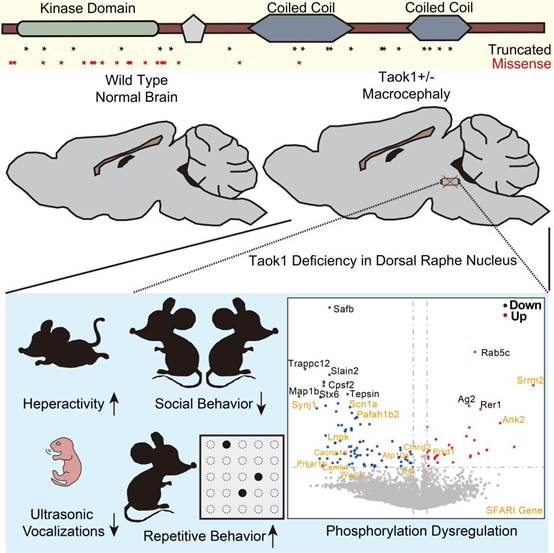
On August 31, 2023, The internationally renowned biology journal Cell Journal online Reports published titled "Taok1 haploid insufficient dosage in mice led to the dorsal raphe nucleus autistic behavior research papers (https://www.cell.com/cell-reports/fulltext/S2211-1247 (23), 01089-6). The study was carried out by Qiu Zilong's research team of Shanghai Key Laboratory of Environment and Child Health, Ministry of Education, Xinhua Hospital Affiliated to Shanghai Jiao Tong University School of Medicine, Songjiang Research Institute/Center of Excellence for Brain Science and Intelligent Technology Innovation (Institute of Neuroscience), Chinese Academy of Sciences/Shanghai Jiao Tong University School of Medicine.
Autism spectrum disorder (ASD), also known as autism, is a type of neurological developmental disease that occurs in infants and young children. The main clinical characteristics are social disorders and repetitive behaviors. The incidence rate is about 0.29% in China. The occurrence of autism is highly related to genetic factors, 2 and single gene mutations have been shown to explain at least 10-15% of the causes of autism. With the extensive development of autism genetic sequencing projects, more and more risk genes for autism have been identified, and the proportion of the disease that can be explained by a single gene mutation has been increasing.
In collaboration with Fei Li, Director of Xinhua Hospital Affiliated to Shanghai Jiao Tong University College of Medicine, Zilong Qiu's research team focused on a new frameshift mutation in the TAOK1 gene in the whole exome second-generation sequencing data of 772 autism core families. The neurodevelopmental disorder associated with TAOK1 has been officially listed by OMIM (Online Mendelian Inheritance in Man) in 2021 as MIM # 619575. Neurodevelopmental disorders associated with TAOK1 mutations have a high degree of heterogeneity, with common symptoms including autism, intellectual impairment, behavioral abnormalities, neonatal feeding difficulties, hypotonia, facial deformities, deformed giants, and joint relaxation. Large-scale second-generation sequencing in autistic populations provides further evidence that TAOK1 is associated with neurodevelopmental disorders. TAOK1 has been identified as a high confidence risk Gene for autism and is included in the SFARI Gene, but little has been reported about the pathogenesis of TAOK1.
The research team combined mouse genetics, animal behavior and histochemistry experiments, and found that insufficient Taok1 haplodose can lead to the core symptoms of autism in mice, such as abnormal vocalization in young mice, reduced social preference, and repetitive and stereotypical behaviors, accompanied by developmental abnormalities such as head enlargement, abnormal cortical neuron migration, decreased forelimb tension, and weight loss. Using immunofluorescence staining and targeted recombination in active populations (TRAP), the team found that Taok1 was found in the dorsal raphenucleus, The neuronal excitability of DRN was associated with autism-like phenotype. Using sparse labeling, electron microscopy and phosphoprotein spectroscopy, it was demonstrated that Taok1 deletion would lead to structural and phosphorylation network abnormalities in DRN neurons. Conditionally knocking out Taok1 in DRN or VGLUT3-positive neurons was sufficient to cause the mice to develop an autism-like phenotype. Supplementing with wild-type TAOK1 in adulthood, rather than with kinase-malfunctioning Taok1, saved the autism-like phenotype in mice with insufficient TAOK1 haplodose.
This study is the first to construct a TAOK1 haplodose-underdose model mouse that mimics neurodevelopmental disorders and demonstrates its potential as a model mouse in the field of autism and neurodevelopment research. In terms of genetic mechanism, it is proved that haplodose insufficiency is a possible mechanism of TAOK1 mutation. This study provides further evidence for the role of DRN in regulating the core phenotype of autism, and suggests that the abnormal function of DRN phosphorylation network and vGLut3 neurons may be associated with the development of autism. This finding provides important evidence for in-depth understanding of the mechanism of autism, and provides a new idea for further intervention and improvement of the core symptoms of autism.
The study was conducted by Dr. Wang Jincheng, Center of Excellence for Brain and Intelligence, Chinese Academy of Sciences, and Senior Researcher Qiu Zilong, Songjiang Research Institute/Center of Excellence for Brain and Intelligence, Shanghai Jiaotong University Medical School, is the corresponding author of the paper. Dr. Li Weike from the Center of Excellence for Brain and Intelligence of the Chinese Academy of Sciences, doctoral students Li Zimeng, Dr. Shi Yuhan, Shan Shifang, Dr. Zhang Yufang, Yuan Yiting, and Dr. Han Wenjian from the Songjiang Research Institute, and Xue Zhenyu from the Ninth People's Hospital Affiliated to Shanghai Jiao Tong University participated in the study. The research has also been strongly supported by the Chinese Academy of Sciences Center of Excellence for Brain and Intelligence Optical platform, experimental animal platform, electron microscope technology platform, gene editing platform, molecular cell technology platform, Xu Xiaohong's research group and Shanghai Easy Computation Biotechnology Co., LTD.
reference
1. Zhou, H., Xu, X., Yan, W., Zou, X., Wu, L., Luo, X., Li, T., Huang, Y., Guan, H., Chen, X., et al. (2020). Prevalence of Autism Spectrum Disorder in China: A Nationwide Multi-center Population-based Study Among Children Aged 6 to 12 Years. Neurosci Bull 36, 961-971. 10.1007/s12264-020-00530-6.
2. Folstein, S., and Rutter, M. (1977). Genetic influences and infantile autism. Nature 265, 726-728. 10.1038/265726a0.
3. Sztainberg, Y., and Zoghbi, H.Y. (2016). Lessons learned from studying syndromic autism spectrum disorders. Nat Neurosci 19, 1408-1417. 10.1038/nn.4420.
4. Spark (2018). SPARK: A US Cohort of 50,000 Families to Accelerate Autism Research. Neuron 97, 488-493. 10.1016/j.neuron.2018.01.015.
5. Wang, J., Yu, J., Wang, M., Zhang, L., Yang, K., Du, X., Wu, J., Wang, X., Li, F., and Qiu, Z. (2023). Discovery and validation of novel genes in a large Chinese ASD cohort. Biol Psychiatry. 10.1016/j.biopsych.2023.06.025.


